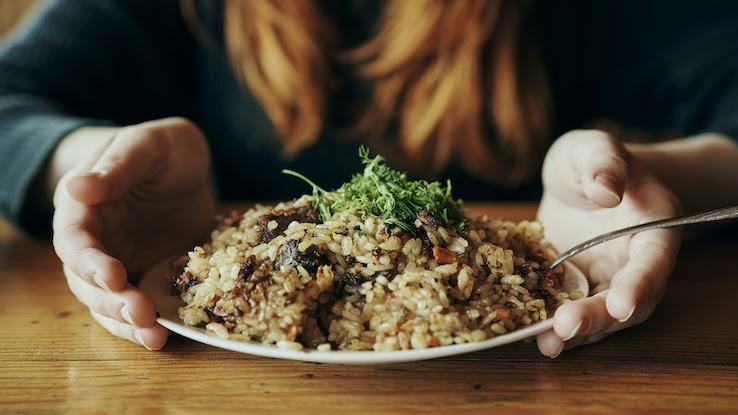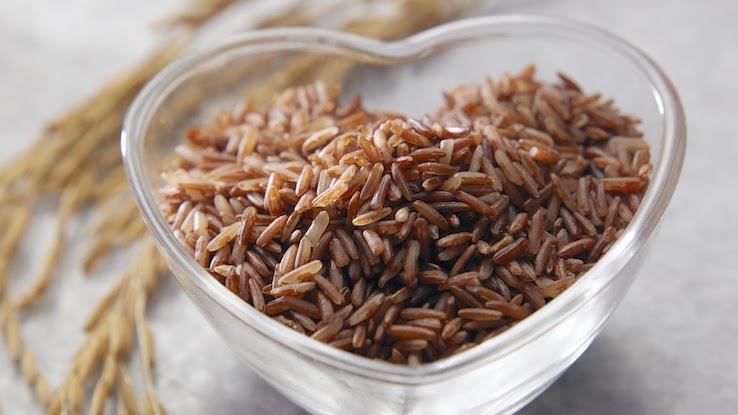Low Fat Chicken Long Grain and Wild Rice Casserole

Whole grains are an excellent source of complex carbohydrates and fiber, making them the healthiest type of grain a person can eat. In fact, the Dietary Guidelines for Americans suggest that whole grains should make up at least 50% of all the grains in your diet.
One important example of a whole grain is brown rice, which is unrefined rice that retains its original outer layers, giving it its characteristic color. Unrefined rice can also be black, red or purple. Regardless of the hue, research has shown that unrefined rice is by far a healthier option when compared to white rice. Here are a few ways eating brown rice can improve your overall health.
A diet high in fiber can improve your health overall by decreasing your risk of developing certain cancers and cardiovascular (heart) disease. Research has shown that eating brown rice, which is high in fiber, can significantly lower your risk of colon and breast cancers. Additionally, fiber encourages your body to burn fat by helping you stay satiated longer after you eat it.

Fiber also plays an important role in blood sugar management for people with diabetes — but fiber-rich brown rice might also lower your diabetes risk. Harvard researchers discovered that eating at least two servings of brown rice per week may lower your risk of developing diabetes. Specifically, a 32% reduction in the risk of developing Type 2 diabetes was observed in people who ate three daily servings of a whole grain such as brown rice. White rice intake was associated with an increased risk of developing diabetes.
It's an Excellent Source of Vitamins, Minerals and Antioxidants
Brown rice is rich in many important vitamins such as B1 (thiamine), B2 (riboflavin), B3 (niacin), folate, vitamin E and vitamin K. Essential minerals such as phosphorus, calcium, manganese, selenium, iron and zinc are also found in brown rice. Manganese and selenium in particular have antioxidant properties that help fight off free radicals, which can cause genetic mutations and potentially contribute to the development of cancerous cells.

Phenolic acids are another common form of antioxidant in brown rice. Antioxidants have a protective effect on our cells and can help prevent heart disease, diabetes and cancer. The phenols in brown rice are specifically known to aid in preventing colon and breast cancers.
It Improves Cholesterol & Aids in Maintaining a Healthy Weight
Rice bran oil, which is found in brown rice, may increase your body's "good" high-density lipoprotein (HDL) cholesterol and decrease your "bad" low-density lipoprotein (LDL) cholesterol. This is because rice bran oil contains molecules known as plant sterols, which alter the process of cholesterol reabsorption in your body. Additionally, research has demonstrated the amount of fat you digest can be reduced when you eat brown rice, suggesting this grain can help you maintain a healthy weight when paired with other nourishing food options.

It Supports Cardiovascular and Brain Health
Eating brown rice can provide several cardiovascular (heart) benefits, such as reducing your risk of developing atherosclerosis (plaque buildup in your blood vessels) or stenosis (narrowing of the vessels), both of which can lead to serious consequences. In addition, eating brown rice can lower your risk of developing metabolic syndrome, which is a condition that may lead to heart disease, stroke and diabetes.

Brown rice can help decrease your total cholesterol levels, which in turn helps contribute a neuroprotective effect to your brain. High cholesterol levels have been associated with certain neurodegenerative disorders that cause nerve cells to die. One study suggested that to obtain the most brain-boosting benefits from brown rice, you should eat the germinated form of the grain.
It Promotes Strong Bones
The high magnesium content in brown rice makes it particularly effective in maintaining bone health, as magnesium and calcium work together to help keep your bones strong. Research has shown that foods high in magnesium may prevent bone loss and can be helpful for people with diseases that affect bone density, such as osteoporosis and arthritis.

Rice is a popular addition to meal plates around the world. Its nutritional benefits are extensive, and brown rice is an excellent whole grain option that's easy to obtain, easy to make and helpful for improving many systemic health issues such as obesity, high cholesterol and diabetes.
Health content reviewed by Dr Samantha Miller, MBChB
Resource Links:
https://pubmed.ncbi.nlm.nih.gov/29235555/
https://health.gov/our-work/food-nutrition/2015-2020-dietary-guidelines/guidelines/
https://www.mayoclinic.org/healthy-lifestyle/nutrition-and-healthy-eating/in-depth/whole-grains/art-20047826
https://www.hsph.harvard.edu/nutritionsource/food-features/rice/
https://pubmed.ncbi.nlm.nih.gov/24158434/
https://www.ncbi.nlm.nih.gov/pmc/articles/PMC6025443/
https://link.springer.com/article/10.1007/s12017-016-8427-5
https://medlineplus.gov/ency/article/002423.htm
https://aces.nmsu.edu/pubs/_e/E142/welcome.html
https://www.mayoclinic.org/healthy-lifestyle/nutrition-and-healthy-eating/in-depth/fiber/art-20043983
MORE FROM SYMPTOMFIND.COM
Low Fat Chicken Long Grain and Wild Rice Casserole
Source: https://www.symptomfind.com/health/brown-rice-healthy-grain?utm_content=params%3Ao%3D740013%26ad%3DdirN%26qo%3DserpIndex
0 Response to "Low Fat Chicken Long Grain and Wild Rice Casserole"
Post a Comment